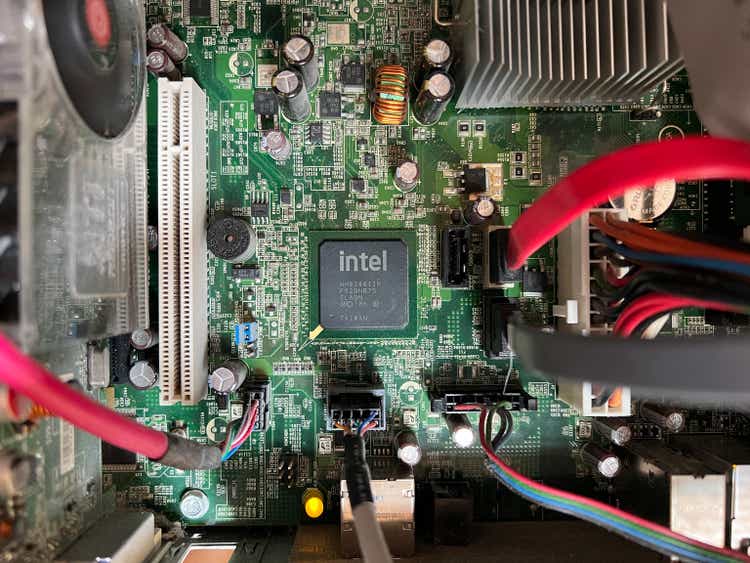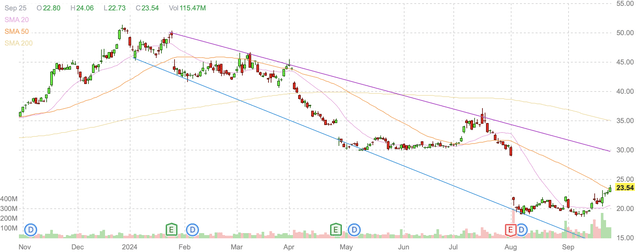Summary:
- Intel’s struggles continue with disappointing earnings, layoffs, and suspended dividends, but potential for recovery exists through foundry development and strategic asset sales.
- Cost cuts and potential segment sales, including interest from Qualcomm and Apollo Global Management, could drive Intel’s turnaround and valuation increase.
- Intel’s future hinges on foundry success, AI and datacenter growth, and overcoming delays and market risks, with a potential share price reaching $25.50-$29.70 before the end of 2024.
- Risks include delays in development, continued GPU dominance in AI, and a weak Chinese market, which could hinder Intel’s recovery and growth prospects.
FinkAvenue
Intel (NASDAQ:INTC) has been in a sticky situation for the last several years. Since 2020 and the Chipping, which marked Intel’s inability to keep up with AMD (AMD) in 7nm chip technology, and NVIDIA (NVDA) in market valuation, Intel has been in search of a reset that never came. More recently, it appears Intel may have finally reached a capitulatory bottom from which it must once again pivot. Moreover, there appears an increasing likelihood that it will need to sell part or all of itself to more capable operators.
Last month, Intel reported poorly received earnings and disappointing guidance, including that it would let go 15% of the company and suspend its dividend in the fourth quarter. Intel had an adjusted EPS of $0.02 on revenue of $12.83 billion, which was below expectations for EPS of $0.10 and revenue of $12.95 billion. Intel’s AI and datacenter revenue was $3.05 billion, and revenue from network and edge came in at $1.34 billion. Intel’s foundry segment had revenue of $4.3 billion, and the company’s Mobileye (MBLY) revenue came in at $440 million.
Intel’s revised guidance was for third-quarter revenue of $12.5-$13.5 billion, down from prior expectations for about $14.4 billion. Intel also guided to an adjusted loss of $0.03 per share for the quarter, where analyst expectations were for adjusted earnings per share of $0.30. Intel also announced they would reduce the company’s headcount by about 15,000, as well as cut gross capex from $34 billion to between $25 billion and $26 billion.
The cost cuts Intel announced likely should have been implemented a while ago, and also appear at least partially related to some prior announcements. For example, earlier this year Intel put on hold the buildouts in both Ohio and Magdeburg, Germany. Therefore, there is some likelihood that there will be forthcoming reductions to equipment orders related to these facilities.
Intel’s decision to become a more competitive foundry operator continues to be a core goal, but there is now also the potential for Intel to split into separate segments, including the possibility that a competitor might pursue the acquisition of all or part of the company. At the same time, the U.S. government and domestic chip designers are highly supportive of the endeavor to develop greater foundry capacity within the country. European support is also evident and a meaningful reason Intel is developing a facility in Germany.
Nonetheless, it must be understood that developing processors and foundries are distinct businesses with disparate objectives and business models. Most notably, foundry margins are substantially lower than what is realized from designing processors. Those lower margins are commensurate with the reduced risk that should exist within the foundry model. At the moment, building out Intel’s foundry ambitions is a costly endeavor that is significantly contributing to Intel’s losses, but also building a book of future business.
So long as Intel continues to build out these capacities and maintain its design plans, it will be difficult to predict where Intel’s margins may end up in any given quarter. It is likely they will oscillate between the high 30 percent and mid 40 percent range between now and the end of 2026. Similarly, it is unclear when Intel again achieve free cash flow, and it is becoming exceedingly unlikely for it to occur in the next few quarters without a segment sale.
There has been some speculation that Qualcomm (QCOM) may be interested in acquiring Intel’s design business, and potentially all of the company. While it may be possible for Qualcomm to buy some part of Intel, such as its PC chip business, it is highly likely that an attempt to wholly acquire the company would be met by significant antitrust scrutiny.
If Intel were interested in shedding some of its assets in an effort to concentrate on foundry development, it is possible that multiple competitors may be interested in parts of the company. There is also the possibility that Intel continues to reduce its position in Mobileye, or potentially sell a majority stake to an interested party.
There has also been some speculation that Apollo Global Management (APO) is interested in investing in Intel. This may indicate Apollo recognizes the apparent capitulatory drop and potential bottom that Intel shares recently put in, but could also indicate an attempt to take a part of Intel private.
If Intel does not sell itself or divest a significant part, and the company can maintain its existing trajectory in foundry, as well as AI and datacenter, it appears likely that is sales could increase by over ten percent in both % in 2025 and 2026. This will likely require renewed strength within China, as well as continued global adoption of AI PCs. The most problematic part of the puzzle for Intel appears to be within datacenter, where it is not clear whether Intel possesses compelling enough products to effectively compete.
Given the potential for Intel to turn itself around, including ramping up its foundry business and potentially recapture share in PCs and datacenter, I believe Intel is undervalued and likely to reprice into the mid to high $20s before the end of 2024. Another catalyst to a higher valuation could come in the form of a significant segment sale, including the potential for there to be a bidding war for parts of Intel.
I believe a forward price to earnings multiple of between 17 and 18 is reasonable for Intel by the end of 2024, with a reasonable probability that it can earn between $1.50 and $1.65 per share in 2026. This results in a price range of between $25.50 and $29.70 per share. This range is also where Intel shares appear to be presently headed, and within the range of its recent downtrend. I would not be surprised for Intel to test the top of this range during the year’s final quarter.
INTC daily candlestick chart (Finviz.com)
Risks
Risks to Intel include Intel continued delays. Intel has experienced significant delays in its prior design and manufacturing goals, and there is some reasonable probability that there will be future delays as well. I would be particularly dubious of Intel’s four-year timetable for developing five process nodes.
Another risk is that GPUs continue to capture the majority of the artificial intelligence market, shifting datacenter and cloud computing budgets away from Intel’s products.
A weak Chinese market is also a risk to Intel. This could take the form of weak demand or Intel being further restricted from competing within the marketplace due to regulations imposed by either the United States or China.
Conclusion
Intel recently underwent a capitulatory drop following its reporting of worse than expected quarterly results, as well as plans to at least temporarily suspend its dividend. This drop took Intel into undervalued territory and brought with it speculation that competitors may be interested in acquiring some or all of the company. Similarly, it appears Apollo expressed some interest in investing in Intel at these levels. Intel is unlikely to stay in the low $20s, and is likely to reprice higher in anticipation of a partial sale or a significant investment by an asset manager, including one that may act as an activist to instigate further action and transactions.
Analyst’s Disclosure: I/we have a beneficial long position in the shares of INTC either through stock ownership, options, or other derivatives. I wrote this article myself, and it expresses my own opinions. I am not receiving compensation for it (other than from Seeking Alpha). I have no business relationship with any company whose stock is mentioned in this article.
Seeking Alpha’s Disclosure: Past performance is no guarantee of future results. No recommendation or advice is being given as to whether any investment is suitable for a particular investor. Any views or opinions expressed above may not reflect those of Seeking Alpha as a whole. Seeking Alpha is not a licensed securities dealer, broker or US investment adviser or investment bank. Our analysts are third party authors that include both professional investors and individual investors who may not be licensed or certified by any institute or regulatory body.
